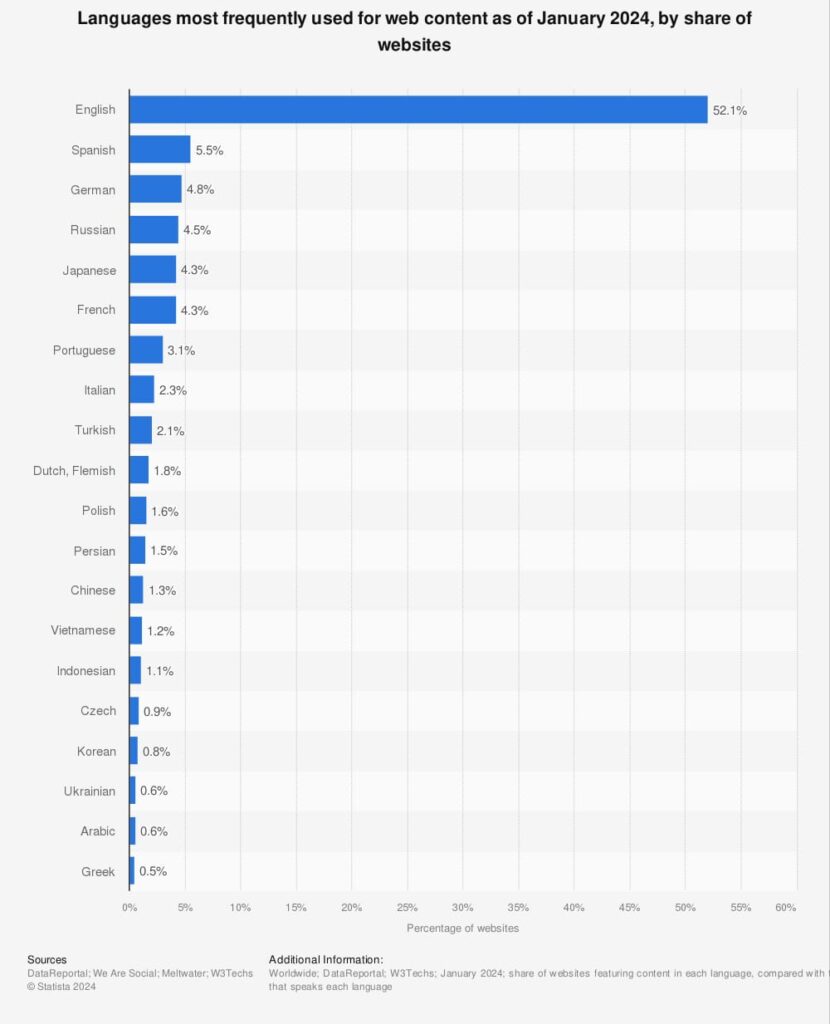What is website localization? And you may wonder why you need to know about it.
According to statista, you have over 5 million users navigating the internet and of that only 26% understand English. But more than 64% of websites are in English. This infers more than 75% of users struggle to utilize internet facilities.

Pic credits: Statista
How can we make it easier for them? Confused?
Let’s set up a big picture now.
Imagine you have arrived in Spain for a vacation. You’re using a local Spanish phrase book to communicate with locals. However, you will encounter difficulties because the locals use various idioms, cultural norms, and social references. Your word on translation falls flat, leaving you feeling like an outsider on the streets of Spain.
This is how your international visitors would feel like when they landed your website which is just translated.
So what’s the difference you found here?
The translation is converting the words from one language to another, but localization is like adding chocolate sauce to your pancake for a morning meal where you impart the local flavors over it and create the best experience out of it. You are making them feel native, by adapting the entire experience to resonate well with the local customers and their preferences.
But enough of all definitions let’s further get into action. This guide will take you through
- Planning of localization strategy
- How to prepare your website for the global market
- Content translation
- Localizing visuals and UI
- SEO for localized website
- Testing & Launching
So ready to explore details on what is website localization and how to make it happen successfully to be a global powerhouse? Grab your explorer hat and discover the ways!
Why website localization is important?

Website localization fetches a strong customer base globally. It has pretty good brand loyalty among customers. It is the best and unique marketing strategy for targeting region specifically. Following are the major improvements you could see when your website gets localized.
Better user experience:
It goes beyond a simple word-to-word translation and helps in assisting the content to fit not only linguistically, but culturally as well. It directly addresses the practical needs of local audiences, thus making them feel comfortable and providing an overall great experience.
Increased market reach:
Website localization leads to tapping new markets. This increases the organic traffic, high user engagement, and conversion rate.
Competitive advantage:
Not everyone in the market would invest in localization. By investing in localization you can stand distinct from others in the industry and popularity among the audience.
Improved SEO:
Localized websites typically rank higher in local search engine results.. Local keywords, meta tags, and relevant content can help you improve your site’s visibility and attract more organic traffic from target regions.
To know about SEO localization strategy read here
Better conversion rates:
Users are more likely to purchase or use your services if the website is in their native language and tailored to their cultural context. Localization improves trust and credibility, resulting in higher conversion rates.
Develop brand trust and loyalty:
When users see that a brand has tried to localize its website, they develop trust and loyalty. They see the brand as thoughtful and respectful of their culture, which promotes a positive brand image and long-term customer relationships.
Complying with local regulations:
Different countries have different rules governing online content, privacy, and commerce. Localization ensures your website follows local laws and regulations, avoiding potential legal problems and fines.
Better customer support:
With localization, you can even provide support in local languages easily, making it easier to help customers with resolving issues easily.
Enhanced cultural relevance:
Localization tailors your content specifically to that area and reflects in cultural norms, customs holidays, etc in line with that particular region. This makes it easier and more relevant to frame marketing campaigns and promotions accordingly.
Boost sales and revenue:
Your products and services are better accessible to your global audience which can drive growth and expand your business internationally.
Website localization process: A step-by-step guide

By now you would be convinced how website localization improves your business. It is just more than a word-by-word translation. You need to fit your business with more cultural and linguistic relevance.
Let’s start to know more about website localization workflow and how you have to take it forward. Being a very important business process it’s important to carry it out very carefully and strategically.
Step-1: Initial planning and strategizing
The first step serves as the basis for developing and implementing your localization strategy. Begin by conducting an in-depth market analysis. What about demand, competition levels, and cultural differences? For example, your product could be in high demand in Japan but not in Brazil.
Following this basic level of analysis, set your global expansion goals, such as increasing market reach by 50% in the first year, increasing user engagement by 30%, and increasing global sales by 25%.
Finally, assemble a highly skilled team of linguists, localization experts, project managers, and technical personnel. It is critical to seek assistance from local experts who can provide cultural insights into that region.
Step 2: Content preparation
Next, list all of the content types that require localization. Include all types of content, such as text, images, video, and multimedia. Organize and categorize all the documents in the respective categories like marketing materials, product descriptions and support documents, etc.
Utilize localization management tools and CMS platforms to get the translation-ready content. Take all the forms of content including URLs, meta tags, etc.
Finally craft a localization kit that comprises style guides, glossaries, translation memories, etc. Include all the instructions that are associated with brand voice, tone and terminology preferences.
Step 3: Localization process
The localization process begins with translation which can be done with the help of professional translators. Use automation tools, such as translation memory systems, to ensure consistency and correctness.
Make sure that your content is consistent with local customs and expectations. Twist the colors, images and design elements as and when needed.
Finally, change the data formats such as dates, currencies, and measurement units. Take care, and support right-to-left languages as well.
Step 4: Quality Assurance
To begin with, check the linguistic accuracy involved by reviewing translations to ensure accuracy and cultural relevance. Engage native speakers to proofread and edit.
Next comes, testing the localized website’s functionality, including links, forms, and interactive elements. Use localization testing tools to detect and resolve any issues.
Finally, UX testing involves gathering feedback from real users in the target market on the usability and experience of the localized website. Incorporate changes based on user feedback.
Step 5: Implementation & Launch
Integrate localized content back into your CMS or website platform. Ensure that all localized versions of the website are properly linked and accessible to your target market.
Conduct pre-launch final testing to ensure everything works as expected and is in line with your audience preferences. Look for any remaining issues or inconsistencies.
Launch a localized website in your target market(s). Keep an eye on the site for any issues that arise after launch and address them as soon as possible.
Step 6: Post-launch and Maintenance
Finally, continuously monitor the localized website’s performance with analytics tools. Keep track of metrics like traffic, user engagement, conversion rates, and customer feedback.
Regularly update localized content to reflect any changes to the original website. Localize new content as it is added to ensure consistency across all versions of the site.
Provide customer support in local languages. Respond promptly to any localization-related issues or questions.
Collect feedback from users and local stakeholders to identify areas for improvement. Utilize the feedback to enhance your localization strategies and processes.
FAQs:
1. What is a localization style guide?
A document that contains guidelines associated with translation and localization of content that ensure consistency, quality, and cultural relevance. This document covers all the language requirements, its tone and voice preferences, terminology, grammar, punctuation, formatting, cultural guidelines, examples, and brand guidelines. This guide assists translators and localization specialists in developing high-quality, culturally relevant content that is consistent with the brand’s identity and messaging.
2. How do I localize content in SEO?
To localize for SEO you may have to incorporate the relevant keywords in the targetted language, make the content suitable for the local’s taste and optimize your business in local business listing, etc.
You may have to ensure to use a country-specific URL structure and adapt the user design accordingly. Make sure you optimize your digital content mobile mobile-friendly as well
3. How does browser localization work?
Browser language works by detecting the local language and its regional settings. This is determined by the browser’s local settings and preferences. The content is then displayed based on the locals’ testing. This process could be automatic translations, localized versions and dynamically changing the settings based on the detected settings.
4. How long does it take to localize a website?
The time taken to localize a website varies based on its complexity and business requirements. Generally, it takes 2-4 weeks for a simple less complex website and between 3-9 weeks for a complex large website.
Signing off:

Businesses are booming everywhere with the help of digital advancements and technologies. It has become so easy that you can deliver requirements that are requested from any part of the world. The only challenge here is to make it as convenient as possible for the end users and stand out from your competitors.
Talk to us if you need any assistance with your website localization requirements!